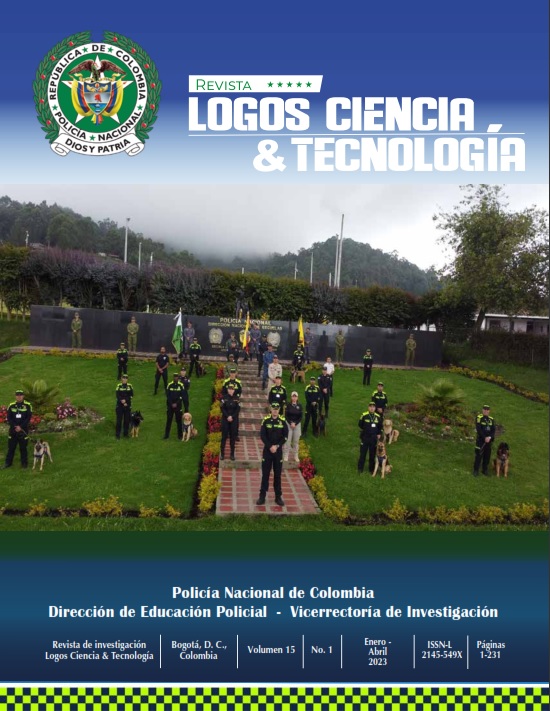Wood species detection from chemical array sensors by using L1 regularization and Gaussian Mixture Models
DOI:
https://doi.org/10.22335/rlct.v15i1.1642Keywords:
statistical learning, dimensionality reduction, mixture models, electronic noses, wood industryAbstract
Species identification from timber helps combat ilegal wood trafficking. In the present work, it is shown a method that aims to detect wood species from previously cut and stored pieces through the interaction of the volatile compounds that they emanate with an array of chemical sensors (electronic nose). The device processes the response of the chemical sensor array using linear regularization and probabilistic machine learning methods trying to resemble current biometric systems. In particular, this method includes a heuristic parameter estimation stage on the signals provided by the sensor array, followed by a variable selection stage through L1 regularization, to finally use Gaussian mixture models [GMMs] for the process of probabilistic modeling. As a result, a performance (measured by EER) of 17.5 % is obtained for the detection of four wood species; and, for the particular case of Sapán, an EER of 12 % is achieved. In conclusion, this biometric approach gives good results compared to previous works, taking into account that in the present work, the experiments are carried out in conditions that are closer to reality.
Downloads
References
Agritix. (2016). Xylorix: Macroscopic wood identification system. https://www.xylorix.com
Baietto, M., Pozzi, L., Wilson, A., y Bassi, D. (2013). Evaluation of a portable MOS electronic nose to detect root rots in shade tree species. Computers and Electronics Agriculture, 96, 117-125. https://doi.org/10.1016/j.compag.2013.05.002
Baietto, M., Wilson, A., Bassi, D., y Ferrini, F. (2010). Evaluation of three electronic noses for detecting incipient wood decay. Sensors, 10(2), 1062-1092. https://doi.org/10.3390/s100201062
Cabral, E., Simas, R., Santos, V., Queiroga, C., Da Cunha, V., De Sá, G., Daroda, R., y Eberlin, M. (2012). Wood typification by Venturi easy ambient sonic spray ionization mass spectrometry: The case of the endangered Mahogany tree. Journal of Mass Spectrometry, 47(1), 1-6. https://pubmed.ncbi.nlm.nih.gov/22282083/
Carmel, L., Levy S., Lancet, D., y Harel, D. (2003). A feature extraction method for chemical sensors in electronic noses. Sensors and Actuators B: Chemical, 93(1), 67-76. https://doi.org/10.1016/S0925-4005(03)00247-8
Chawla, N. V., Bowyer, K. W., Hall, L. O., y Kegelmeyer, W. P. (2002). SMOTE: synthetic minority over-sampling technique. Journal of artificial intelligence research, 16, 321-357. https://www.jair.org/index.php/jair/article/view/10302
Cordeiro, J., Li, R., Takahashi, E., Rehder, G., Ceccantini, G., y Gruber, J. (2016). Wood identification by a portable low-cost polymer-based electronic nose. RSC Advance, 6(111). https://pubs.rsc.org/en/content/articlelanding/2016/ra/c6ra22246c
Corporación Autónoma Regional de Santander [CAS] (2016). En Santander hay 13 especies de flora y 12 de fauna priorizados para su conservación. http://cas.gov.co/index.php/sala-de-prensa/453-ensantander-hay-13-especies-de-flora-y-12-de-faunapriorizados-para-su-conservacion.html
Fedele, R., Galbally, I., Porter, N., y Weeks, I. (2007). Biogenic VOC emissions from fresh leaf mulch and wood chips of Grevillea robusta (Australian Silky Oak). Atmospheric Environment, 41(38), 8736-8746. https://doi.org/10.1016/j.atmosenv.2007.07.037
Forest Research Institute Malasy y University Tunku Abdul Rahman [FRIM&UTAR] (2018). My wood: Mobile Wood identification for 100 malaysian timbers. http://mywoodid.frim.gov.my
Friedman, J., Hastie, T., y Tibshirani, R. (2009). The Elements of Statistical Learning. https://link.springer.com/book/10.1007/978-0-387-84858-7
Ghasemi-Varnamkhasti, M., Razdari, A., Yoosefian, S., Izadi, Z., y Rabiei, G. (2019). Selection of an optimized metal oxide semiconductor sensor (MOS) array for freshness characterization of strawberry in polymer packages using response surface method (RSM). Postharvest Biology and Technology, 151, 53-60. https://doi.org/10.1016/j.postharvbio.2019.01.016
James, G., Witten, D., Hastie, T., y Tibshirani, R. (2013). An introduction to statistical learning. Springer. https://link.springer.com/book/10.1007/978-1-4614-7138-7
Kalaw, J., y Sevilla, F. (2018). Discrimination of wood species based on a carbon nanotube/polymer composite chemiresistor array. Holzforschung, 72(3), 215-223. https://www.degruyter.com/document/doi/10.1515/hf-2017-0097/html
Mantilla, N., Ruiz, L., Ortega, H., Paja, M., y Sepúlveda, A. (2020). A low cost electronic nose with a GMM-UBM approach for wood species verification. ICPRAM-2020, 333-341. https://scholar.google.com/citations?view_op=view_citation&hl=es&user=Deodh2sAAAAJ&citation_for_view=Deodh2sAAAAJ:d1gkVwhDpl0C
Mantilla, N., Ruiz, L., Ortega, H., y Sepúlveda, A. (2021). Identificación de especies de maderas locales mediante el uso de nariz electrónica y aprendizaje automático: Un experimento preliminar. INGE CUC, 17, 188-200. https://revistascientificas.cuc.edu.co/ingecuc/article/view/2570
Porras, D., Sarria, M., y Sepúlveda, A. (2020). Speaker Verification system based on articulatory information from ultrasound recordings. DYNA, 87(213). http://www.scielo.org.co/scielo.php?pid=S0012-73532020000200009&script=sci_arttext&tlng=en
Reynolds, D., Quatieri, T., y Dunn, R. (2000). Speaker verification using adapted gaussian mixture models. Digital Signal Processing, 10(1-3), 19-41. https://doi.org/10.1006/dspr.1999.0361
Ruiz-Jiménez, L. F. (2018). Detección de los insectos de la subfamilia Triatominae basado en narices electrónicas. Technical report, Universidad Industrial de Santander.
Urrego, D., Pérez, M., Polanco, C. y Pérez, M. (2012). Control del aprovechamiento ilegal de flora a partir de la anatomía de siete especies maderables en estado de amenaza. Aportes a la política nacional ambiental. Revista Criminalidad, 54(1), 259-281. http://www.scielo.org.co/scielo.php?script=sci_arttext&pid=S1794-31082012000100004
Wheeler, E. A., y Baas, P. (1998). Wood identification-a review. IAWA journal- International Association of Wood Anatomists, 19(3), 241-264. https://doi.org/10.1163/22941932-90001528
Wilson, A., Lester, D., y Oberle, C. (2005). Application of conductive polymer analysis for wood and Woody plant identifications. For. Ecol. Manage., 209(3), 207-224. https://doi.org/10.1016/j.foreco.2005.01.030
Wilson, A. (2012). Application of a conductive polymer electronic-nose device to identify aged woody samples. En S. Yurish, I. Chilibon, V. Carvalho, S. Gervais-Ducouret (eds.). Proceedings of The 3rd International IARIA Conference on Sensor Device Technologies and Applications, Rome, Italy. Xpert Publishing Services: Wilmington, DE. (pp. 77-82). https://www.fs.usda.gov/research/treesearch/45153
Wilson, A. (2013). Diverse Applications of Electronic-Nose Technologies in Agriculture and Forestry. Sensors, 13, 2295-2348. https://www.mdpi.com/1424-8220/13/2/2295
World Wildlife Fund [WWF] (2017). 15 especies colombianas de árboles amenazados. http://www.wwf.org.co/?uNewsID=299073
Yan, J., Guo, X., Duan, S., Jia, P., Wang, L., Peng, C., y Zhang, S. (2015). Electronic nose feature extraction methods: A review. Sensors, 15(11), 27804-27831. https://doi.org/10.3390/s151127804
Yu, M., Liu, K., Zhou, L., Zhao, L., y Liu, S. (2015). Testing three proposed DNA barcodes for the Wood identification of Dalbergia odorifera T. Chen and Dalbergia tonkinensis Prain. Holzforschung, 70(2), 127-136. https://doi.org/10.1515/hf-2014-0234
Zhao, P., y Jun, C. (2016). Wood species identification using spectral reflectance feature and optimal illumination radian design. Journal of Forestry Research, 27, 219-224. https://doi.org/10.1007/s11676-015-0171-4
Downloads
Published
Versions
- 2022-12-16 (3)
- 2022-12-12 (2)
- 2022-12-08 (1)
Issue
Section
License
Copyright (c) 2022 Revista Logos Ciencia & Tecnología

This work is licensed under a Creative Commons Attribution 4.0 International License.
This journal provides free and immediate access to its content (https://creativecommons.org/licenses/by/4.0/legalcode#languages), under the principle that making research available to the public free of charge supports greater global knowledge exchange. This means that the authors transfer the Copyrights to the journal, so that the material can be copied and distributed by any means, as long as the authors’ recognition is maintained, and the articles are not commercially used or modified in any way.
































